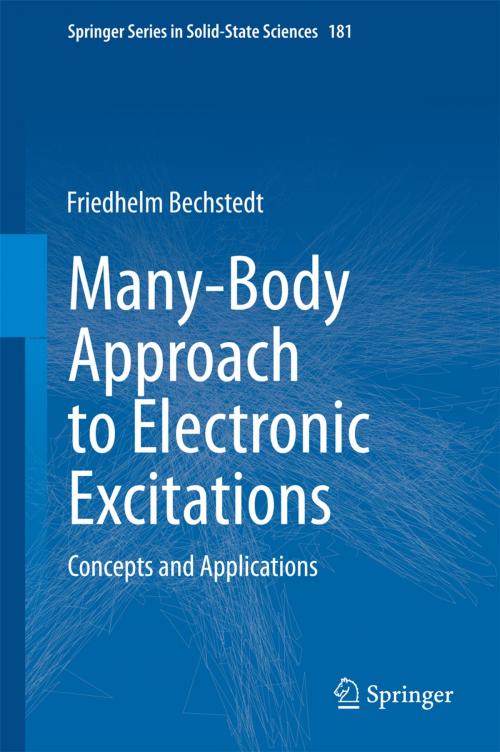Many-Body Approach to Electronic Excitations
Concepts and Applications
Nonfiction, Science & Nature, Science, Physics, Spectrum Analysis, Solid State Physics| Author: | Friedhelm Bechstedt | ISBN: | 9783662445938 |
| Publisher: | Springer Berlin Heidelberg | Publication: | December 1, 2014 |
| Imprint: | Springer | Language: | English |
| Author: | Friedhelm Bechstedt |
| ISBN: | 9783662445938 |
| Publisher: | Springer Berlin Heidelberg |
| Publication: | December 1, 2014 |
| Imprint: | Springer |
| Language: | English |
The many-body-theoretical basis and applications of theoretical spectroscopy of condensed matter, e.g. crystals, nanosystems, and molecules are unified in one advanced text for readers from graduate students to active researchers in the field. The theory is developed from first principles including fully the electron-electron interaction and spin interactions. It is based on the many-body perturbation theory, a quantum-field-theoretical description, and Green's functions. The important expressions for ground states as well as electronic single-particle and pair excitations are explained. Based on single-particle and two-particle Green's functions, the Dyson and Bethe-Salpeter equations are derived. They are applied to calculate spectral and response functions. Important spectra are those which can be measured using photoemission/inverse photoemission, optical spectroscopy, and electron energy loss/inelastic X-ray spectroscopy. Important approximations are derived and discussed in the light of selected computational and experimental results. Some numerical implementations available in well-known computer codes are critically discussed. The book is divided into four parts: (i) In the first part the many-electron systems are described in the framework of the quantum-field theory. The electron spin and the spin-orbit interaction are taken into account. Sum rules are derived. (ii) The second part is mainly related to the ground state of electronic systems. The total energy is treated within the density functional theory. The most important approximations for exchange and correlation are delighted. (iii) The third part is essentially devoted to the description of charged electronic excitations such as electrons and holes. Central approximations as Hedin's GW and the T-matrix approximation are discussed.(iv) The fourth part is focused on response functions measured in optical and loss spectroscopies and neutral pair or collective excitations.
The many-body-theoretical basis and applications of theoretical spectroscopy of condensed matter, e.g. crystals, nanosystems, and molecules are unified in one advanced text for readers from graduate students to active researchers in the field. The theory is developed from first principles including fully the electron-electron interaction and spin interactions. It is based on the many-body perturbation theory, a quantum-field-theoretical description, and Green's functions. The important expressions for ground states as well as electronic single-particle and pair excitations are explained. Based on single-particle and two-particle Green's functions, the Dyson and Bethe-Salpeter equations are derived. They are applied to calculate spectral and response functions. Important spectra are those which can be measured using photoemission/inverse photoemission, optical spectroscopy, and electron energy loss/inelastic X-ray spectroscopy. Important approximations are derived and discussed in the light of selected computational and experimental results. Some numerical implementations available in well-known computer codes are critically discussed. The book is divided into four parts: (i) In the first part the many-electron systems are described in the framework of the quantum-field theory. The electron spin and the spin-orbit interaction are taken into account. Sum rules are derived. (ii) The second part is mainly related to the ground state of electronic systems. The total energy is treated within the density functional theory. The most important approximations for exchange and correlation are delighted. (iii) The third part is essentially devoted to the description of charged electronic excitations such as electrons and holes. Central approximations as Hedin's GW and the T-matrix approximation are discussed.(iv) The fourth part is focused on response functions measured in optical and loss spectroscopies and neutral pair or collective excitations.















